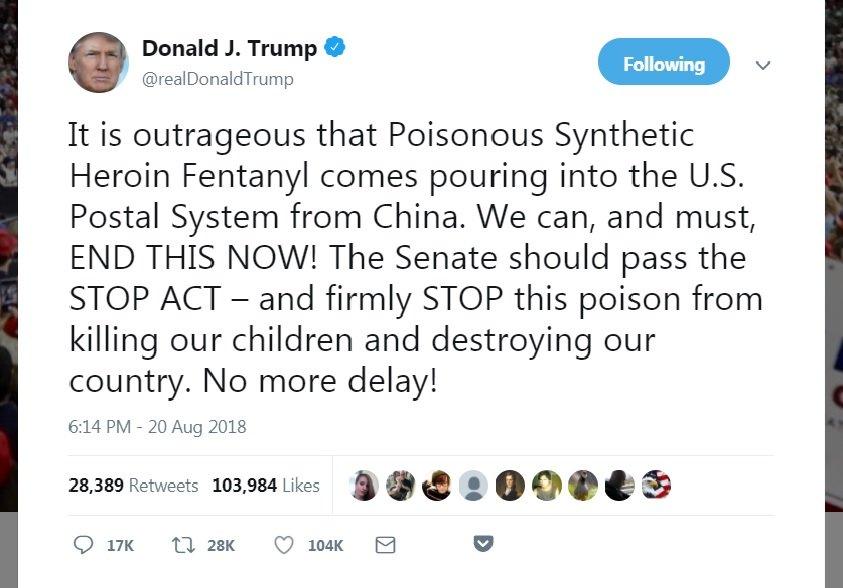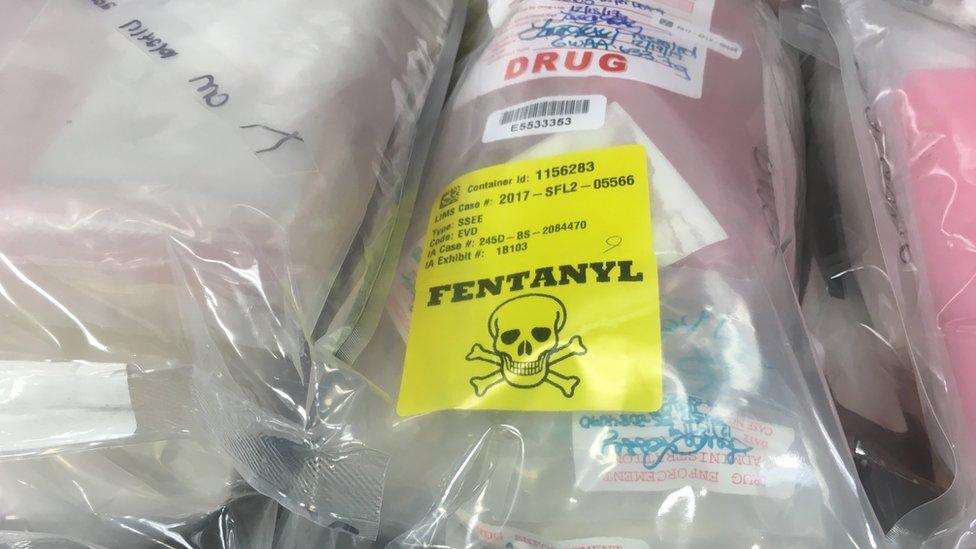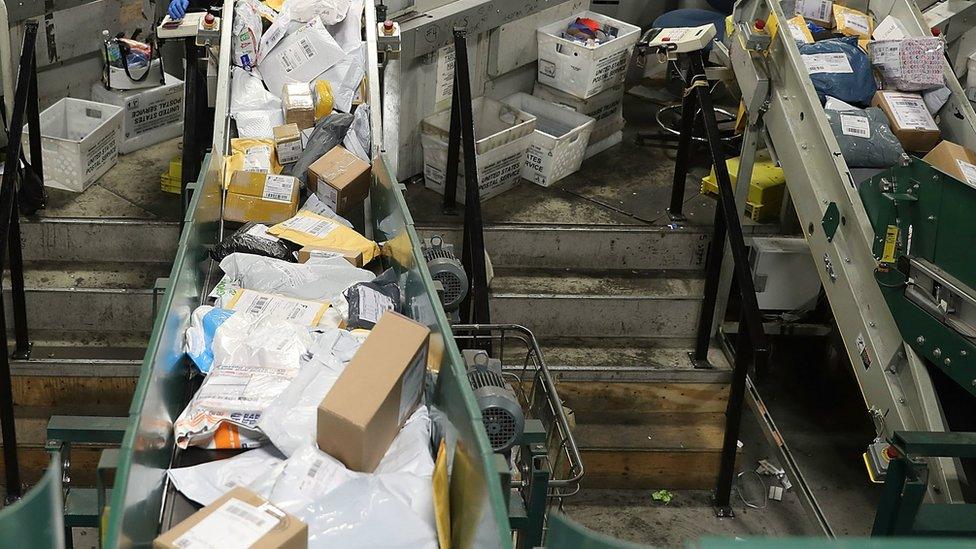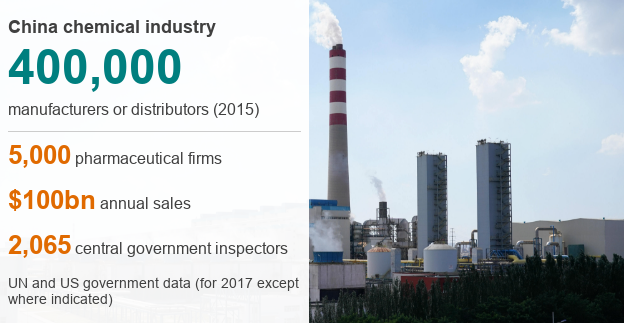Fentanyl crisis: Is China a major source of illegal drugs?
- Published

China has one of the largest chemical industries in the world
Amid tension between China and the US over trade, there's also friction over another issue - the illegal trade in synthetic drugs.
The US believes factory-produced opioids - powerful painkillers increasingly abused by US citizens - are being made in China and sold from there too.
One of the main ones is fentanyl - 50 to 100 times stronger than morphine - which is only approved in the US for severe pain arising in cases like treatment for cancer.
President Trump has called out China publicly.

China, while not denying there's a problem, has hit back at claims that most illegal fentanyl is from China.
A senior Chinese official, Yu Haibin of the National Narcotics Control Commission, said there was "no proof" of this, and described President Trump's comments and "unacceptable" and "irresponsible".
Mr Yu had earlier spoken about growing drug demand in the US as the real problem, and suggested there should be better intelligence sharing with China., external
There's no doubt a lot of these chemicals are produced in China - although in exactly what quantities is impossible to tell.
And despite the rhetoric, China has been taking some steps to address the problem.
Dangerous chemicals
These synthetic drugs are cheap to make, are sold on the internet and sent by post, either directly to the US or to trafficking networks based in Mexico.
On arrival at their destination they can be mixed in very small amounts with other drugs, especially heroin, to increase their potency.
"Fentanyl is potentially lethal, even at very low levels. Ingestion of doses as small as 0.25mg can be fatal," states the US Drug Enforcement Agency (DEA).

It's also relatively easy to alter its chemical structure to produce similar substances - known as fentanyl analogues - to bypass legal controls.
"The countless possibilities to create new compounds by small changes in chemical structures pose a growing challenge to international control of the opioid trade," states the UN Office for Drugs and Crime., external
Growing concerns - not just in US
The US authorities are increasingly worried about opioid abuse, and have now put all fentanyl-related products into the most dangerous class of drugs.
In testimony before Congress, Assistant Secretary of State Kirsten Madison described the situation as the most "severe drug crisis" the US has ever faced.

She said that in 2017, more than 40% of the 72,000 drug overdose deaths in the US involved synthetic opioids like fentanyl., external
Health statistics from Canada show that last year, 72% of deaths related to opioid abuse were believed to involve fentanyl or related substances - up from 55% in 2016.
Europe's drug monitoring agency the EMCDDA, which covers the EU plus Turkey and Norway, said in a report this year that "the number of synthetic opioids has grown rapidly in Europe since the first substance was reported in 2009"., external
The China connection
US officials are unequivocal that China is the main source for fentanyl and similar drugs.
In October 2017, the US authorities announced the first ever indictments against two Chinese individuals for conspiracy "to distribute large quantities" of fentanyl as well as other opioids.

The US authorities say drugs are being shipped by mail
Katherine Pfaff, spokesperson for the US Drug Enforcement Agency, told the BBC that interceptions from the US postal system, information from people on the ground, and tracking cyber footprints, leads them to believe a "significant amount" comes from China.
The European drug monitoring agency report states: "It appears that most shipments of new fentanyls coming into Europe originate from companies based in China."
However, it added that there have also been some examples of illegal production by laboratories in Europe.
And, although the Chinese authorities don't officially accept that most fentanyl is produced in China, they have taken some action.
Martin Raithelhuber, an expert on synthetic drugs with the UN Office on Drugs and Crime, says China now has restricted more than 150 chemicals that can be used to create synthetic drugs.
"They have been quite active in introducing national controls," he adds.
The DEA's Pfaff told Reality Check that China is "recognising the problem" and that there's an "on-going, strong working relationship" with the Chinese.
Regulation and corruption
But do the Chinese have a problem regulating their large and rapidly growing pharmaceutical industry?
Drugs policy expert at the Rand Corporation in the US, Bryce Pardo, describes their regulatory capacity as "limited".
"Gaps in regulatory design, the division of responsibility between provincial and central governments, and lack of oversight and government and corporate accountability, increase opportunities for corruption," he says.

"I think it is fair to say that a lack of regulatory capacity, perhaps regardless of the letter of the law, certainly limits their ability to control the industry," says John Collins, head of the International Drug Policy Institute, external at the London School of Economics (LSE).
The other problem is that as more controls are introduced, new chemical substances are produced to get around them.
"The lessons from other countries suggest that effective regulation and enforcement does not ensure the absence of an illicit market," adds Collins.
"In the presence of a demand, supply finds a way."
He believes a more comprehensive approach to managing the overdose crisis in the US is needed, not simply relying on control of supply from abroad.
And that is also part of China's argument - that the US needs to address its growing demand for such drugs, rather than just blaming Beijing.



- Published25 May 2018

- Published6 August 2018

- Published5 February 2018
